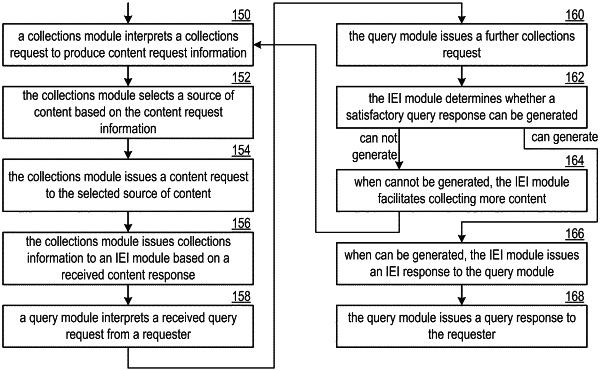| CPC G06N 5/025 (2013.01) [G06F 16/245 (2019.01); G06F 16/24564 (2019.01); G06F 16/24578 (2019.01); G06F 16/90335 (2019.01)] | 9 Claims |

|
1. A method for execution by a computing device, the method comprises:
generating a comparative query entigen group set based on a comparative query in accordance with identigen rules, wherein the comparative query entigen group set represents a most likely interpretation of the comparative query, wherein the generating the comparative query entigen group set based on the comparative query in accordance with the identigen rules includes:
identifying a set of identigens for each word of the comparative query to produce a plurality of sets of identigens,
identifying a comparative aspect of the comparative query,
interpreting, utilizing the identigen rules and in accordance with the comparative aspect, the plurality of sets of identigens to produce a first comparative query entigen group, wherein a set of identigens of the plurality of sets of identigens includes one or more different meanings of a word of the comparative query, wherein a first comparative query entigen of the first comparative query entigen group corresponds to an identigen of the set of identigens having a selected meaning of the one or more different meanings of the word of the comparative query, and
interpreting, utilizing the identigen rules and in accordance with the comparative aspect, the plurality of sets of identigens to produce a second comparative query entigen group, wherein the second comparative query entigen group contrasts the first comparative query entigen group in accordance with the comparative aspect;
obtaining a first response entigen group from a knowledge database based on the first comparative query entigen group of the comparative query entigen group set, wherein the first response entigen group includes the first comparative query entigen group, wherein the obtaining the first response entigen group from the knowledge database based on the first comparative query entigen group of the comparative query entigen group set includes:
identifying a group of entigens of the knowledge database that is the same as the first comparative query entigen group as the first response entigen group, wherein a first entigen of the first response entigen group is the same as a first entigen of the first comparative query entigen group, wherein a second entigen of the first response entigen group is the same as a second entigen of the first comparative query entigen group, and wherein a first entigen relationship between the first and second entigens of the first comparative query entigen group is the same as a second entigen relationship between the first and second entigens of the first response entigen group;
obtaining a second response entigen group from the knowledge database based on the second comparative query entigen group of the comparative query entigen group set, wherein the second response entigen group includes the second comparative query entigen group; and
generating a comparative response based on the first response entigen group and the second response entigen group, wherein the generating the comparative response based on the first response entigen group and the second response entigen group includes:
identifying the comparative aspect of the comparative query;
analyzing the first response entigen group and the second response entigen group utilizing the comparative aspect to produce a comparative response entigen group, wherein the analyzing the first response entigen group and the second response entigen group utilizing the comparative aspect to produce the comparative response entigen group includes:
when the comparative aspect indicates a numerical comparison type:
selecting a mathematical function based on the comparative aspect;
applying the mathematical function to corresponding portions of the first response entigen group and the second response entigen group to produce a numerical response; and
generating the comparative response entigen group based on the numerical response, the first response entigen group, and the second response entigen group; and
when the comparative aspect indicates a qualitative comparison type:
selecting a qualitative comparison based on the comparative aspect;
performing the qualitative comparison on corresponding portions of the first response entigen group and the second response entigen group to produce a qualitative response; and
generating the comparative response entigen group based on the qualitative response, the first response entigen group, and the second response entigen group; and
selecting, for each entigen of the comparative response entigen group, a word associated with the entigen of the comparative response entigen group to produce the comparative response.
|